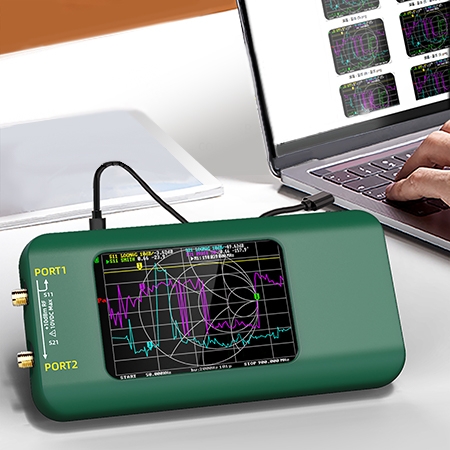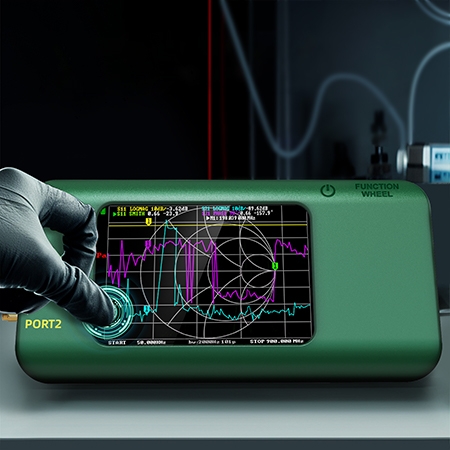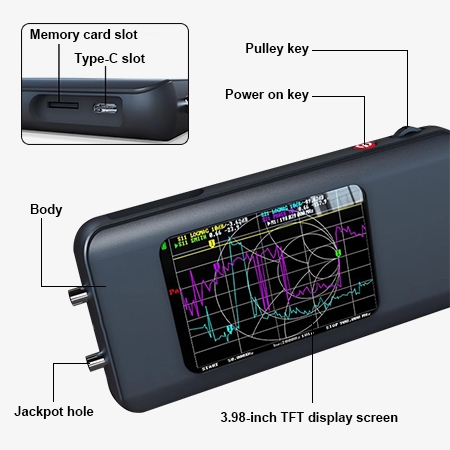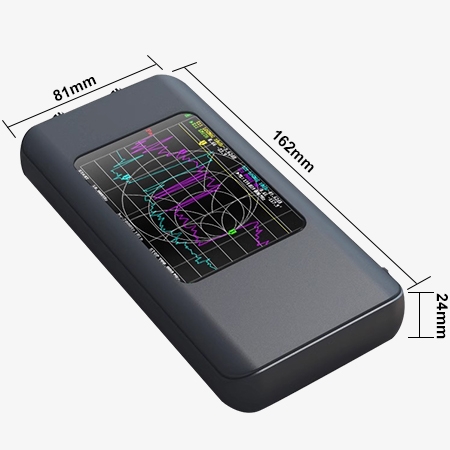The VNA Portable Vector Network Analyzer focuses on portability, basic accuracy, and practicality. It is ideal for basic S-parameter testing and debugging of passive and active components such as filters, antennas, and amplifiers.

Intelligent and Precise RF Measurements
- The VNA analyzer has a measurement frequency range from 10 kHz to 1.5 GHz, meeting the test requirements of low-frequency circuits to very high frequency (VHF) and ultra-high frequency (UHF) RF components. Its frequency accuracy is better than 2 parts per million (ppm), and its stability is better than 0.5 ppm, ensuring a highly accurate and stable frequency reference for measurement results, making it suitable for measurements requiring high frequency precision.
- The VNA's measurement range (dynamic range) varies with increasing frequency, reaching an optimal 70 dB in the 50 kHz to 300 MHz range, enabling clear discrimination of components with significant attenuation or gain. A built-in intelligent chip enables precise and fast measurements, featuring fast response, high accuracy, and a wide measurement range.

High-Speed Scanning and Portable Design
- The portable VNA boasts a scanning speed of up to 600 points per second (at a 4kHz resolution bandwidth) and a maximum of 401 scan points (increased by connecting to host software), achieving fast scanning with sufficiently fine resolution. It supports simultaneous display of four measurement traces and eight markers, and can save seven setups, providing basic comparison, analysis, and quick recall capabilities for convenient daily testing.
- The portable vector network analyzer features a compact 3.98-inch color display and a built-in 3000mAh high-capacity lithium battery, significantly enhancing its portability and outdoor flexibility. It is ideal for field maintenance, teaching experiments, or where bench space is limited.
The VNA portable's dual-port design utilizes a mixer, switched via an internal RF switch, to perform S11 and S21 measurements. It also performs TDR and DTF measurements using IFFT calculations.
Applications
The first is component research and development and characteristic analysis to help engineers optimize device design; the second is electronic product production quality inspection to quickly detect whether the product meets performance standards; the third is communication and RF system debugging to ensure the normal operation of the system; the fourth is aerospace to accurately test its RF performance in a wide frequency range and complex environment to meet stringent technical indicators.

Electronics

Communications

Aviation

Components
| Model | SISCO-VNA-P5 |
| Measurement Frequency | 10kHz~1.5GHz |
| RF Output | OdBm (±2dB, fundamental) |
| Frequency Accuracy | <2ppm |
| Frequency Stability | <0.5ppm |
| Measurement Range | 70dB(50kHz 300MHz)/60dB(300-900MHz)/40dB(0.9G-1.5GHz)·Port SWR:<1.1 |
| Display Screen | 3.98-inch TFT color screen (320×480) |
| Power Supply | Built with a 3000mAh lithium battery, maximum charging current of 2A |
| Number of Calibration Points | up to 401 (optional), unlimited when connecting to a PC·Number of scanning points: up to 401 (optional), unlimited when connecting to a PC-Scanning point speed:>600 pls (RBW=4000Hz) |
| Display Tracking | 4 |
| Mark | 8 |
| Set Save | 7 |
| Packaged Weight | 330g |
Structure Diagram

Dimensional Diagram

Q1: How to use a vector network tester?
A1: First, ensure the instrument has been preheated and stabilized. Clean the connectors between the test port and the DUT and check that the connecting cables are intact. Next, enter the instrument's operation interface, set parameters such as the test frequency range, number of points, and power according to your test requirements, and select the appropriate test mode. Calibrate according to specifications. After calibration, correctly connect the DUT to the test port, start the test, and wait for the instrument to acquire data.
Q2: What types of vector network testers are there?
A2: Vector network testers are primarily categorized as benchtop, portable, modular, and specialized types integrated into semiconductor test systems. There are also specialized vector network testers for high-frequency bands such as millimeter-wave and terahertz, as well as variants with enhanced features such as time-domain analysis and multi-port expansion to meet the needs of different industries and applications.
Q3: What factors affect the test accuracy of a vector network tester?
A3: The test accuracy of a vector network tester is affected by a variety of factors, including the instrument's own systematic errors, calibration quality, test environment, DUT characteristics, the quality of test accessories and connectors, and the operator's professionalism. These factors combine to determine the accuracy and reliability of the final measurement results.
Tips: What Parameters Should You Focus on When Purchasing a Vector Network Analyzer?
Focus on three core parameters: First, confirm whether the frequency range covers the device under test (for example, for 5G testing, choose a millimeter-wave model; for standard WiFi, choose a model within 6 GHz) to avoid buying the wrong model or wasting money. Next, consider accuracy, prioritizing models with a wide dynamic range (e.g., over 100 dB) and low amplitude/phase errors after calibration to ensure reliable data. Finally, consider practicality. Choose the number of ports (multi-interface devices should have at least two ports) based on your needs, whether it includes additional features like noise measurement.
Thank you for buying industrial test and measurement equipment on SISCO.com, all products sold by SISCO and the partner cover a 12 months warranty, effective from the date of receiving the products.
What is covered?
SISCO is responsible for providing free spare parts, and free technical support to assist the customer to repair the defective products until the problem is solved.
What is not covered?
- Product purchased from anyone other than a SISCO store or a SISCO authorized reseller.
- Expendable parts.
- Routine cleaning or normal cosmetic and mechanical wear.
- Damage from misuse, abuse or neglect.
- Damage from use of parts other than SISCO approved.
- Damage from use outside the product’s usage or storage parameters.
- Damage from use of parts not sold by SISCO.
- Damage from modification or incorporation into other products.
- Damage from repair or replacement of warranted parts by a service provider other than a SISCO authorized service provider.
- Damage caused by the application environment not meeting the product usage requirements and the failure to perform preventive maintenance.

